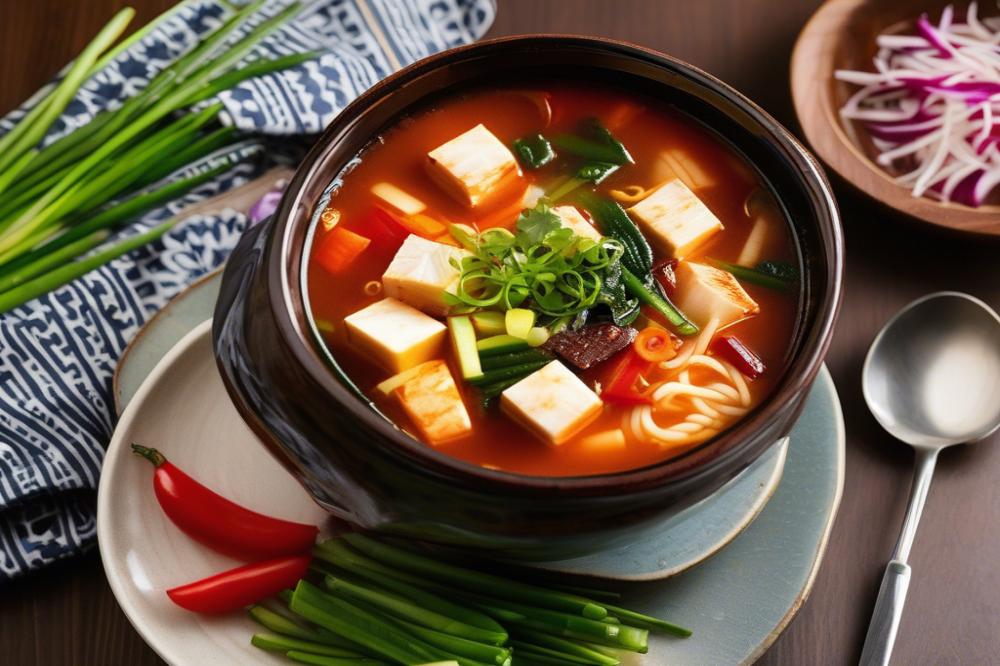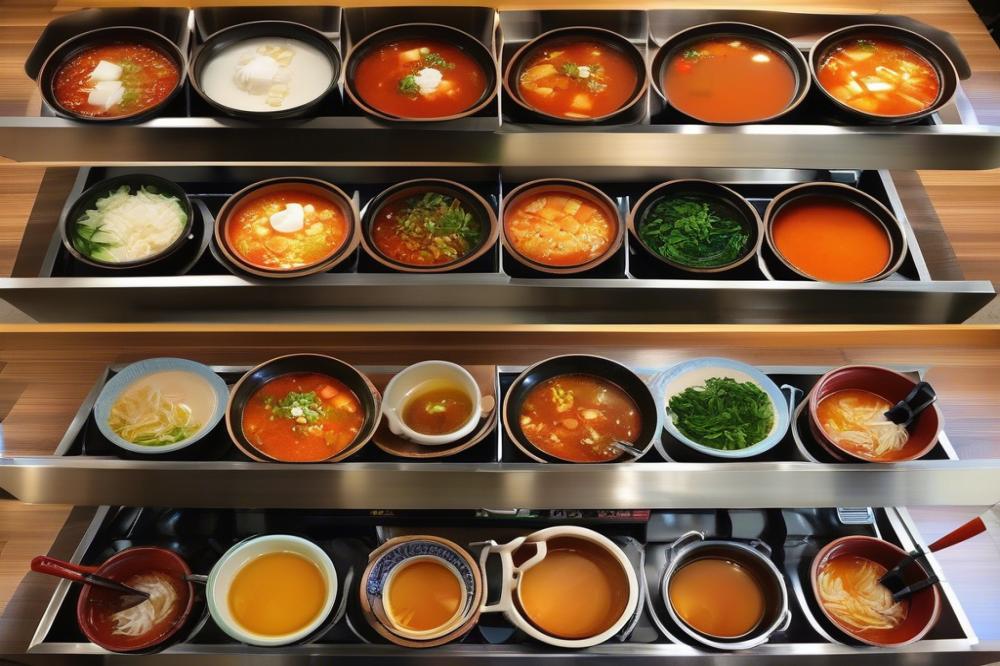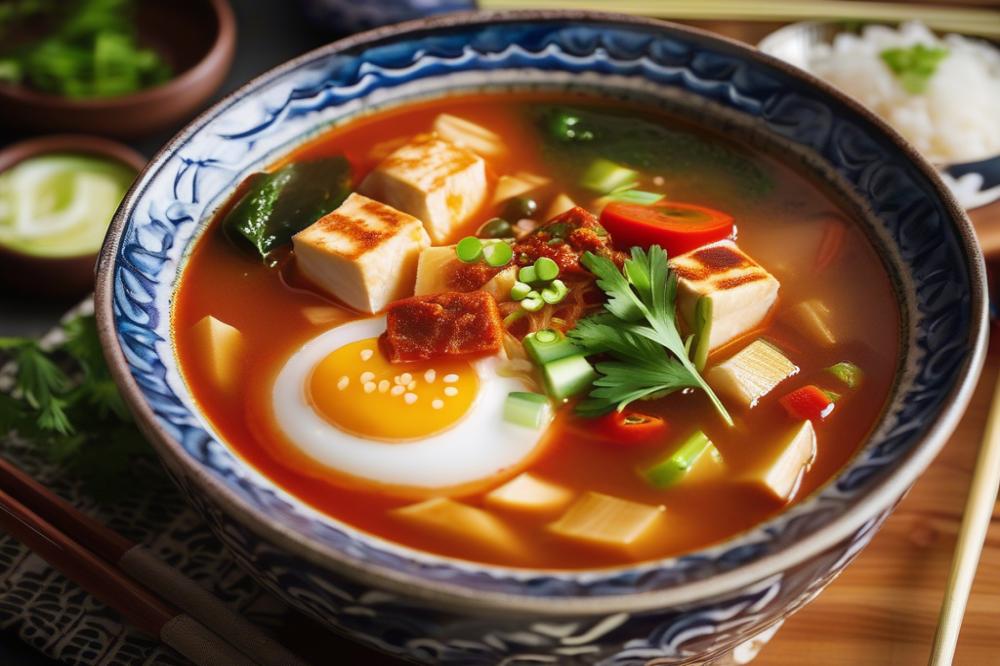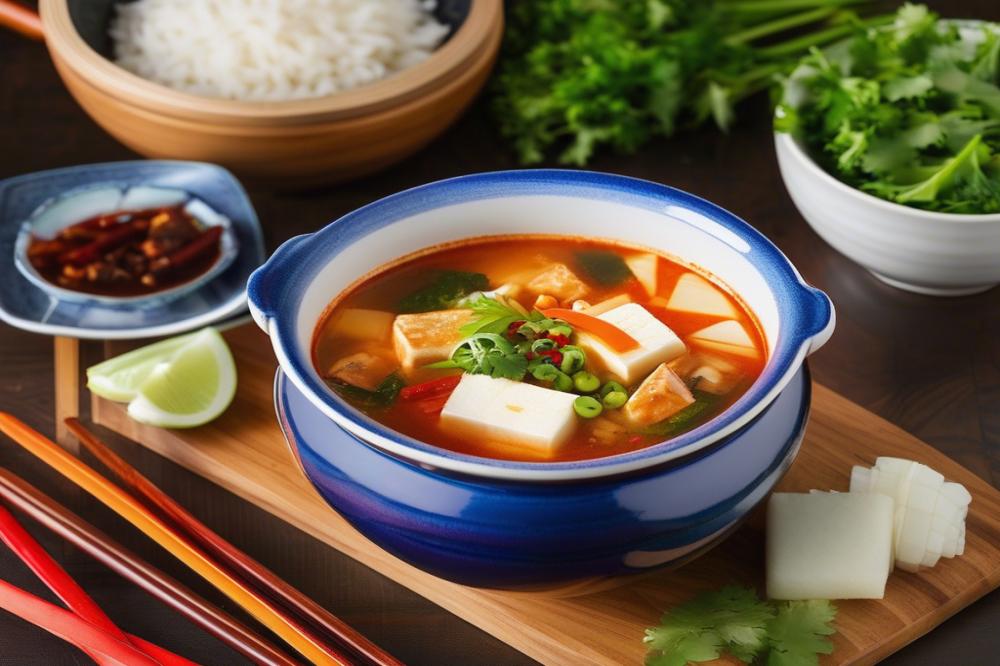Introduction
soondubu jjigae is a beloved dish that showcases the heart of Korean cuisine. This soft tofu stew is rich, comforting, and bursting with flavor. Koreans often turn to comforting foods like this when they need a warm hug on a chilly day. The warm, savory broth envelops the ingredients, creating a dish that warms both the body and the spirit.
Comfort food holds a special place in Korean culture. It offers a sense of nostalgia and community for many. Sharing a hearty meal evokes memories of family gatherings and home-cooked meals, which play an essential role in Korean society. Traditional Korean dishes often focus on using wholesome ingredients that nourish the body and mind.
Spicy stews, in particular, hold significant culinary importance. They come in various styles, each with unique ingredients and flavors. Many people appreciate the vibrant taste that comes from the heat of the spices, making the experience truly satisfying. Tofu recipes, especially, have gained popularity. Offering a healthy meal choice, they can cater to various diets, including vegetarian options. This makes the stew not only versatile but also accessible to everyone.
Enjoying a bowl of soondubu jjigae can feel like a culinary adventure. Preparation is straightforward, making it an ideal choice for a quick dinner. From the first bite, the rich flavors entice the taste buds. It’s no wonder that this comforting dish remains a favorite among many. When you think of food that nurtures the soul, this stew undoubtedly comes to mind.
What is Soondubu Jjigae

Soondubu jjigae is a popular Korean dish known for its warm and comforting qualities. This soft tofu stew is a staple in Korean cuisine. Many enjoy it as a hearty meal that can be prepared easily. The main ingredient, silken tofu, gives it a unique texture, making each spoonful smooth and creamy.
Description of soft tofu stew
This spicy stew delivers a savory broth that warms the soul. Soft tofu serves as the base, soaking up all the flavors from the other ingredients. Traditionally, it features spicy gochugaru, or Korean red pepper flakes, adding heat and depth. Vegetables, meat, and seafood can also be included to enhance the dish. People often serve it in a hot stone pot, which helps keep the stew bubbling at the table. This presentation adds to its appeal.
Cultural background and origins of the dish
Soondubu jjigae has deep roots in Korean culture. It originated centuries ago, bringing families together for shared meals and conversations. This dish reflects the Korean philosophy of comfort food. Many consider it a go-to option during cold weather or when feeling unwell. It embodies warmth and the essence of home cooking. Some even believe it has healing properties, making it a popular choice for recovery from illness.
Variety of ingredients used in traditional recipes
Traditional recipes vary widely, as people often customize their own versions. Common ingredients include vegetables like zucchini, mushrooms, and onions. The dish may also contain proteins such as seafood, beef, or even eggs. For those seeking vegetarian options, tofu and vegetables work beautifully. Some prefer spicier versions, adding extra gochugaru or even chili peppers. The flexibility of this tofu recipe allows everyone to find their preferred combination. Quick recipes exist for busy days, ensuring that anyone can enjoy this healthy meal without much hassle.
Ingredients List and Cooking Instructions

Complete List of Ingredients with Quantities
To create this delightful Korean comfort food, gather the following ingredients:
- Soft tofu (about 400 grams)
- Water or vegetable broth (2 cups)
- Korean chili paste (gochujang, 1 tablespoon)
- Korean red pepper flakes (gochugaru, 1 teaspoon)
- Garlic (minced, 2 cloves)
- Scallions (chopped, 2 stalks)
- Sesame oil (1 tablespoon)
- Vegetables (e.g., zucchini and mushrooms, 1 cup mixed)
- Seafood option (like clams or shrimp, 1 cup) or meat (like thinly sliced beef, 100 grams)
- Salt (to taste)
- Black pepper (to taste)
Soft Tofu, Vegetables, Seafood or Meat Options
Soft tofu is the star of the dish, creating a creamy texture. You can choose from various options for proteins. Seafood, such as clams and shrimp, gives a fresh flavor. Alternatively, thinly sliced beef adds heartiness. For a vegetarian version, focus on an array of seasonal vegetables like carrots, zucchini, and mushrooms.
Spices and Seasonings Essential for Authentic Flavor
Key to the depth of a spicy stew are gochujang and gochugaru. These staples of Korean cuisine bring heat and color. Garlic contributes aromatic notes, while sesame oil adds a nutty richness. Adjusting the amount of spice can help achieve your preferred flavor intensity. Always taste as you go!
Step-by-Step Cooking Method
Follow these simple steps for a delightful tofu recipe:
- Start by heating sesame oil in a pot over medium heat.
- Add minced garlic and sauté until fragrant, about 30 seconds.
- Stir in gochujang and gochugaru, letting them mix and cook for another minute.
- Pour in the water or broth, bringing it to a gentle boil.
- Add your chosen protein, followed by the vegetables.
- Carefully spoon in the soft tofu, breaking it into large chunks.
- Simmer everything together for about 10-15 minutes, allowing flavors to meld.
- Season with salt and black pepper to taste.
- Finally, sprinkle chopped scallions on top just before serving.
Preparation Tips for a Savory Broth
A savory broth makes all the difference in this dish. If using water, consider enhancing it with vegetable or mushroom broth for added umami. You can also simmer the broth with a piece of kombu or dried anchovies before making the stew for a more fortified flavor. Allow the broth to cook gently, drawing out the natural flavors of each ingredient.
Cooking Time and Temperature Considerations
Cooking time may vary based on your choice of protein and vegetables. Generally, expect to spend about 20-25 minutes from start to finish. Maintain a medium heat to prevent boiling over, while allowing the stew to simmer. When using quicker cooking ingredients like shrimp, add them later in the process to avoid overcooking.
Nutritional Information

Soondubu jjigae is not only delicious but also nutritious. Each ingredient contributes different values. Soft tofu, the star of this dish, is rich in protein. One cup of soft tofu can contain about 144 calories. It is low in calories, making it a great option for those watching their weight. Vegetables like zucchini, mushrooms, and green onions add essential vitamins and minerals.
When examining the health benefits, tofu stands out. It contains all nine essential amino acids. This makes it a complete protein source for vegetarians. Antioxidants found in vegetables help fight inflammation and support overall health. Many people enjoy comfort food when they feel down. A spicy stew like this can warm the heart and lift the spirits.
Vegetarian and Non-Vegetarian Options
Vegetarian options offer a fantastic mix of flavors. Tofu absorbs spices well, enhancing its taste. Adding various vegetables gives the stew its colorful presentation. In contrast, non-vegetarian versions may include seafood or pork. These additions can enhance the savory broth. Each choice has its own unique flavor profile.
Comparing these options reveals interesting differences. Vegetarian soondubu jjigae remains light and health-friendly. In contrast, meat versions tend to be richer and more filling. Choosing a vegetarian option can provide a quick recipe for a busy night. It brings all the satisfaction of traditional Korean dishes without the added calories from meat.
Soondubu Jjigae as a Healthy Meal Choice
This spicy stew checks many boxes for a healthy meal. Ingredients are generally fresh and straightforward. The combination of tofu and vegetables results in high fiber content. Fiber is essential for good digestion and overall health. Many prefer this dish for its nutritional balance, comfort, and wholesomeness.
Commonly served with rice, the entire meal is complete. It offers a good mix of carbs, proteins, and fats. Enjoying a hot bowl can be both satisfying and nourishing. Eating this often provides an excellent way to incorporate more plant-based foods. Exploring its flavors adds variety and health benefits to your diet.
Serving Suggestions and Variations

Traditional Ways to Serve Soondubu Jjigae
Serving this dish is a delightful experience. Traditionally, it comes bubbling hot in a stone pot. This keeps the stew warm for a longer time. The rich, savory broth offers a comforting texture. Korean cuisine often emphasizes sharing, so provide small bowls for everyone. Each person can ladle out their portion, mixing in flavors as they like. Sometimes, a raw egg is added right before serving, allowing it to gently cook in the hot stew. This adds an extra creaminess to each bite.
Pairing with Rice and Side Dishes
Rice is often served alongside to balance the spiciness. Steamed white rice helps to mellow out the flavors of the spicy stew. Other typical accompaniments include various banchan, or side dishes, commonly found in Korean meals. Kimchi is a favorite choice, bringing a tangy contrast. Pickled radish offers a crunchy texture. A simple salad can brighten the plate too. All of these complementary side dishes enhance the overall dining experience.
Vegetarian and Vegan Adaptations
Many enjoy the versatility of this tofu recipe. For those seeking vegetarian options, replacing seafood or meat with mushrooms or zucchini works wonderfully. Silken tofu is a perfect choice for a creamy consistency. Vegan adaptations can easily be made by avoiding any fish sauce. Simple vegetable broth brings out flavors without compromising the essence of this dish. Adding vegetables like spinach can boost the nutritional value.
Tips for Customizing Spice Levels and Ingredient Preferences
Adjusting spice levels can personalize the dish to your liking. Start with a small amount of gochugaru, the Korean red pepper flakes. You can gradually add more if you want extra heat. For those who prefer milder flavors, reduce the amount of spice used. Ingredients can be swapped based on what you have. Don’t be afraid to experiment with different vegetables or proteins. This flexibility makes it an easy dinner choice, as you can use what’s available. Quick recipes often allow for unique flavors without formal rules. Always remember, cooking should be enjoyable. Feel free to make this stew your own!
Final Thoughts on Soondubu Jjigae
Soondubu jjigae holds a special place in Korean cuisine. This soft tofu stew is more than just a meal; it’s a beloved comfort food that brings warmth and satisfaction. Many families enjoy it together, making it a staple at dinner tables across Korea. The combination of soft tofu, vegetables, and warm broth offers a soothing experience, perfect for rainy days or chilly nights.
As you embark on trying this recipe, you’ll find that it is an easy dinner option that doesn’t require hours of preparation. Gather the ingredients and follow the steps; soon enough, you will have a delicious stew simmering on your stove. Create your own version by adding extras like seafood or meat. Feel free to adjust the spice levels to suit your taste. Cooking this dish can be an exciting adventure.
Exploring traditional Korean dishes opens up a world of flavors and textures. Each recipe carries its own story and history. By cooking soondubu jjigae, you are not just making dinner; you are participating in a rich culinary tradition. Embrace the experience and enjoy every bite. Who knows? This delightful stew might become one of your favorites!



